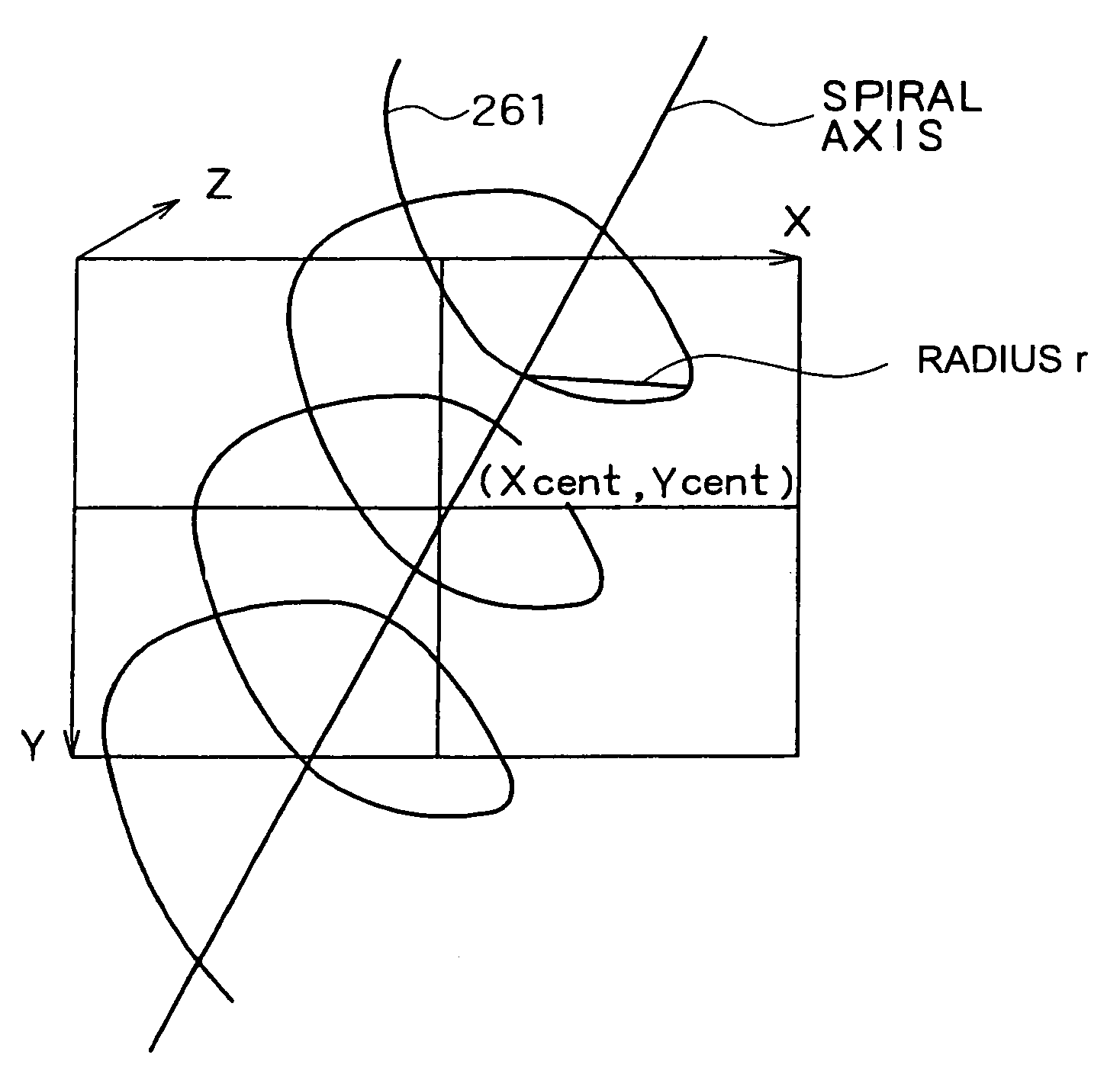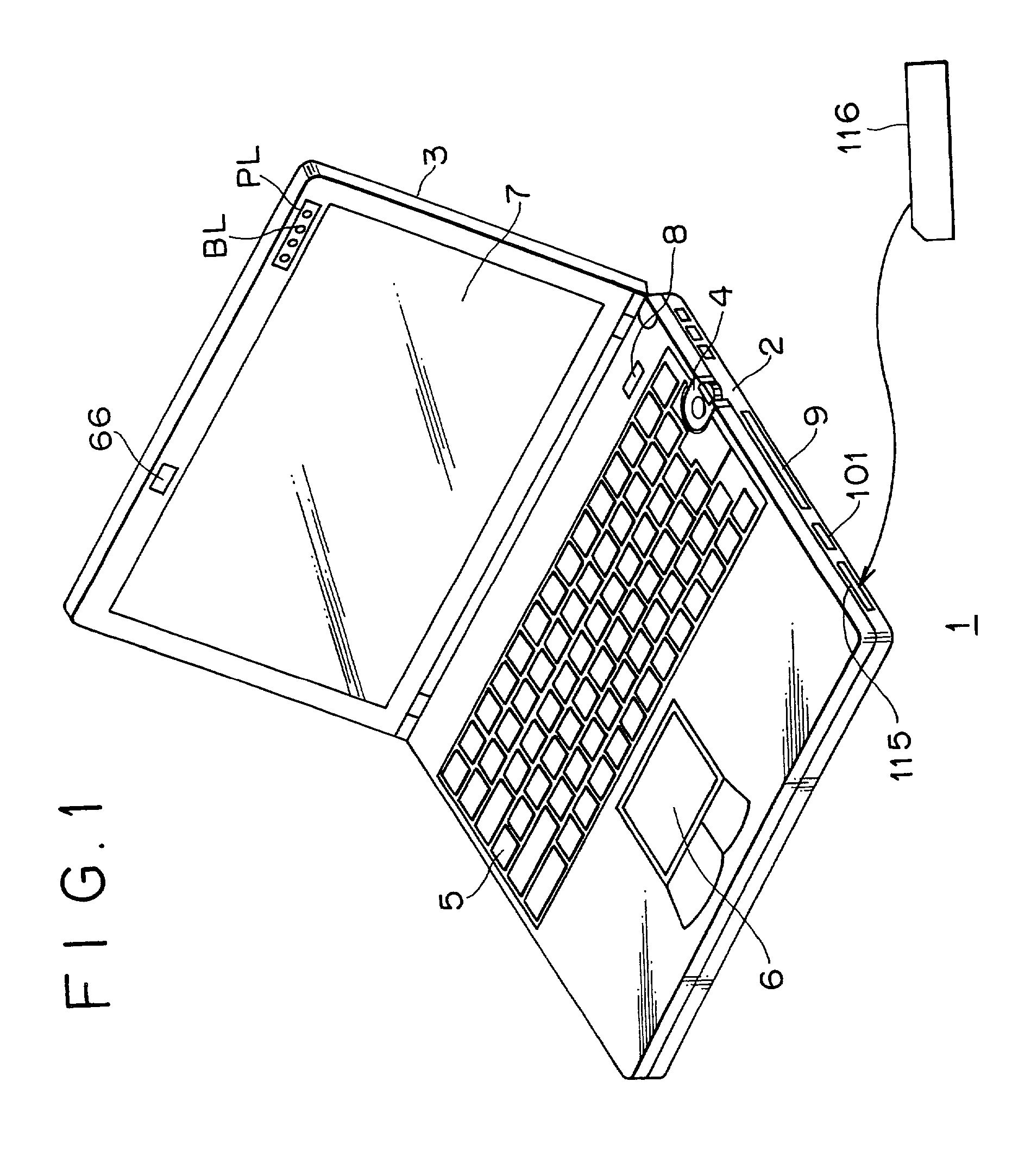[0012]In an information-processing apparatus, preferably, the information-processing apparatus includes representative-thumbnail-selecting means for selecting a specific one of a plurality of thumbnail icons displayed as the array on the virtual spiral as a representative thumbnail icon and representative-thumbnail-icon-array-displaying means for displaying the representative thumbnail icon selected by the representative-thumbnail-selecting means in an array on the virtual spiral. Preferably, a computer-graphic display program includes a representative-thumbnail-icon-selecting step of selecting a specific one of a plurality of thumbnail icons displayed as the array on the virtual spiral as a representative thumbnail icon, and a representative-thumbnail-icon-array-displaying step of displaying the representative thumbnail icon selected at the representative-thumbnail-icon-selecting step in an array on the virtual spiral. With this configuration, the position of each selected representative thumbnail icon becomes obvious and, at the same time, a positional relation between the period of a spiral and the axis of the spiral can be verified so as to provide simple operatability which can be understood intuitively.
[0013]Preferably, the information-processing apparatus includes spiral-layer-synthesizing means for synthesizing a plurality of spiral
layers each comprising the virtual spiral, the spiral axis and the thumbnail icons, and synthesized-layer-displaying means for displaying a synthesized layer produced by the spiral-layer-synthesizing means. Preferably, a computer-graphic display program includes a spiral-layer-synthesizing step of synthesizing a plurality of spiral
layers each comprising the virtual spiral, the spiral axis and the thumbnail icons, and a synthesized-layer-displaying step of displaying a synthesized layer produced at the spiral-layer-synthesizing step. With this configuration, a plurality of spiral
layers each showing a virtual spiral, the axis of the spiral and thumbnail icons can be synthesized and superposed on each other to be displayed as a synthesized layer. In a configuration allowing a plurality of layers to be superposed on each other as such, assume that layers of a new bridegroom and a new bride are superposed on each other in a wedding party as an example. The newly-married couple's loci from the first day of acquaintance up to the wedding party are created on spiral layers separated from each other along spirals with axes different from each other. The synthesized layer obtained as a result of the synthesis can be displayed in such a way that the time axis of the bridegroom's spiral coincides with the time axis of the bride's spiral. The user is thus capable of enjoying a
data display that is abundant in performance effects and of much interest to the user.
[0014]In an information-processing apparatus, preferably, an information-processing apparatus includes thumbnail-icon-extracting means for extracting a specific thumbnail icon from a plurality of thumbnail icons displayed as the array based on the time-axis data on the basis of a predetermined regularity, and data-outputting means for outputting
raw data represented by the specific thumbnail icon extracted by the thumbnail-icon-extracting means. Preferably, a computer-graphic-display program includes a thumbnail-icon-extracting step of extracting a specific thumbnail icon from a plurality of thumbnail icons displayed as the array based on the time-axis data on the basis of a predetermined regularity, and a data-outputting step of outputting
raw data represented by the specific thumbnail icon selected at the thumbnail-icon-extracting step. With this configuration, a plurality of thumbnail icons can be specified from a greater plurality of thumbnail icons on the basis of a predetermined regularity, and data serving as a base for generation of each of the specified thumbnail icons can be output. That is to say, a plurality of thumbnail icons displayed along a time axis in a spiral are specified on the basis of the predetermined regularity such as appearance of a season such as a spring, summer, autumn or winter picture, appearance of a day's predetermined
time zone like a
morning, a day time or a night or detection of a temperature or a
humidity within a predetermined range like detection of a temperature or a humidity higher or lower than a predetermined value, making it possible to display collected data represented by the specified thumbnail icons.
[0016]Furthermore, in an information-processing apparatus, preferably, the predetermined regularity (e.g., a pattern) includes at least a regularity based on a time axis representing at least hours, days, months or years, a regularity based on temperatures or a regularity based on humidity data, and preferably, in a computer-graphic-display program, the predetermined regularity includes at least a regularity based on a time axis representing at least hours, days, months or years, a regularity based on temperatures or a regularity based on humidity data. With this configuration, a predetermined regularity can be designed to comprise at least a regularity based on a time axis including at least a time, a day, a month or a year, a regularity based on temperatures or a regularity based on humidity. Assume a regularity (e.g., a pattern) based on a temperature as an example. With such a regularity, when data for a temperature exceeding typically 30° C. is displayed, the user is capable of viewing people-related data for a
pool, a sea or light dress. In the case of data of low temperatures such as temperatures below 0° C., on the other hand, data that is difficult to express by using only time units can be displayed. An example of such data is data for a cold region such as a
snow area. In addition, the regularity based on a time axis including at least a time, a day, a month or a year, the regularity based on temperatures or the regularity based on humidity can be applied by itself as the predetermined regularity or, as an alternative, those regularities can be superposed on each other to form the predetermined regularity. Thus, it is possible to widen the range of data-display selections and to express data of much interest to the user.
[0017]Moreover, in an information-processing apparatus, the representative-thumbnail-icon-array-displaying means displays the thumbnail icon as a semitransparent display. Preferably, in a computer-graphic display program, at the representative-thumbnail-icon-array-displaying step, the thumbnail icon is displayed as a semitransparent display. With this configuration, by displaying thumbnail icons and representative thumbnail icons semitransparently, data behind the thumbnail icons and the representative thumbnail icons is not concealed completely but visible instead. Thus, the data can be displayed by showing the period and the axis of the spiral as they are. As a result, it is possible to provide simple operatability which can be understood intuitively.
[0018]In addition, in an information-processing apparatus, preferably, an information-processing apparatus further includes visual-point-moving means for arbitrarily moving a visual point of the spiral layer displaying the virtual spiral, the spiral axis and the thumbnail icons. Preferably, the visual-point-moving means automatically moves the visual point of the spiral layer along a time axis. Preferably, the visual-point-moving means moves the visual point of the spiral layer or changes the direction of a visual line of the spiral layer in respectively visual-point parallel-movement processing or visual-line-direction modification processing which is performed in accordance with an operation carried out manually on an operation key set in advance for the visual-point parallel-movement processing or the visual-line-direction modification processing respectively. Preferably, the visual-point-moving means moves the visual point in the visual-point parallel-movement processing in at least the direction of an X, Y or Z axis in a displayed
virtual space. Preferably, the visual-point-moving means moves the visual point in at least one of
yaw,
pitch and roll directions in a displayed
virtual space. Preferably, the visual-point-moving means automatically resets the visual point to an origin's position set in advance after the lapse of a predetermined time since a manual operation to start the visual-point parallel-movement processing or the visual-line-direction modification processing. Preferably, the visual-point-moving means automatically moves the visual point or automatically switches the position of the visual point to another location after the lapse of a predetermined time since a manual operation to start the visual-point parallel-movement processing or the visual-line-direction modification processing. Further, in a computer-graphic-display program, preferably, the information-processing program includes a visual-point-moving step of arbitrarily moving a visual point of the spiral layer displaying the virtual spiral, the spiral axis and the thumbnail icons, and the visual-point-moving step automatically moves the visual point or automatically switches the position of the visual point to another location after the lapse of a predetermined time since a manual operation to start the visual-point parallel-movement processing or the visual-line-direction modification processing. With this configuration, the visual point of a spiral layer displaying a virtual spiral, the axis of the spiral and representative thumbnail icons can be moved automatically or manually. In addition, the visual point can be moved in a
parallel motion in the X, Y or Z direction, and the orientation of a visual line can be changed in a
yaw,
pitch or roll direction. By moving the visual point and changing the orientation of the visual line in this way in conjunction with the application of the regularities described above individually or as a regularity of superposition, performance based on a visual point in complex motion can be displayed in a variety of ways and it is also possible to widen the range of data-display selections and to express data of much interest to the user.
 Login to View More
Login to View More  Login to View More
Login to View More 


